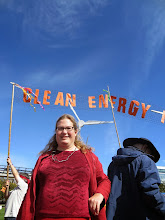Stephen Frantz at the Sacramento Municipal Utilities District has graciously provided more information about the Solar Shares program and how it works today. This is a great reference for how utility owned solar gardens can work.
SMUD SolarShares in a Nutshell
Basic Design
Under a long-term PPA—typically 20 years—SMUD buys energy from a new local PV project installed by a 3rd-party vendor.
SMUD resells this energy to SolarShares participants (“customer”) at a price lower than the PPA price.
The customer buys an annual amount of solar energy by selecting a size for their “virtual rooftop system.” For example, a customer who chooses a 1-KW system receives the equivalent of what would be produced by a 1-KW rooftop system having the same capacity factor as the SolarShares system. SMUD guarantees the amount of energy to be delivered over a 12-month period.
The customer pays a fixed monthly fee and receives a bill credit for the energy produced each month by their virtual system. The credit per kWh is the same as what the customer would earn from a net-energy-metered rooftop system—i.e., full retail.
The size of system offered to a given customer depends on the customer’s annual electricity consumption for the previous 12 months. Smaller users are restricted to smaller systems in order to preclude the possibility of over-generation and make the program available to a greater number of customers.
Likewise, the customer’s annual usage also determines their monthly SolarShares fee. Because larger users receive greater value from net metering due to SMUD’s tiered rate structure, they also pay more per kWh for SolarShares but still pay about the same annual premium as smaller users for participating in the program.
The SolarShares price in cents per kWh is designed to exceed the average grid price the customer would pay over 20 years if grid prices escalate by 3% per year.
The table below summarizes the pricing structure for the initial 1-MW SolarShares project. This structure will change as each additional SolarShares project joins the grid and as the program expands to nonresidential market segments with different rate structures. As the price of succeeding systems falls, fees for first-generation customers will be reduced to reflect the decreasing average PPA price of the entire SolarShares portfolio as it expands.
| Customer Annual Usage (kWh) | |||||||
| Small (≤6,000 kWh/yr) | Medium (6,001-14,000 kWh/yr) | Large (>14000 kWh/yr) | |||||
| Size (kW) | kWh/yr | Monthly Fee | $/kWh | Monthly Fee | $/kWh | Monthly Fee | $/kWh |
| 0.5 | 868 | $10.75 | $0.149 | | | | |
| 1 | 1,736 | $21.50 | $0.149 | $26.50 | $0.183 | | |
| 1.5 | 2,604 | | | $39.75 | $0.183 | | |
| 2 | 3,472 | | | $53.00 | $0.183 | $66.00 | $0.228 |
| 3 | 5,208 | | | | | $99.00 | $0.228 |
| 4 | 6,944 | | | | | $132.00 | $0.228 |
Results to Date
SMUD has built one SolarShares system and will continue to expand the program based on the results from the pilot effort. SMUD’s goal is to keep the system subscribed up to 95% of its full output, with the additional 5% used as a safety margin ensuring that SMUD can keep its delivery commitment to customers in the event the system produces less energy than estimated.
The system was subscribed to the desired level within six months of program inception. Little paid marketing was necessary—media stories and word of mouth were sufficient to produce this level of demand. Approximately 700 customers were sufficient to fully subscribe the system, and there is a persistent waiting list of approximately 60 customers. The current mix by customer size is about 27% small, 51% medium, and 22% large.
SolarShares Potential as a Sustainable Business Model for Utilities
The ability to balance the price per kWh paid by SolarShares customers against the price paid by the utility under the PPA suggests great potential for making distributed PV at least a breakeven proposition for both the program participants and the utility. Moreover, having the utility handle all program administration and resource acquisition removes the first-cost and decision complexity that are now formidable barriers to increased customer uptake of rooftop PV.
Participants benefit from getting a fixed-price renewable product that is priced only moderately above grid price from the outset and that may eventually be cheaper than grid depending on how long they remain in the program.
The utility is able to reduce the cost of adding renewable generation within the distribution grid by having a subset of ratepayers help defray the higher cost of PV relative to other renewables.
The ability to site systems on roof space as well as less developable land gives many community institutions (such as schools) the potential to serve as system hosts and perhaps receive revenue in the form of space leasing, thus forging new partnerships between the utility and its constituencies.
Given these advantages, it is not unreasonable to expect that a SolarShares model can dramatically expand PV market penetration over what would be possible through sheerly private acquisition by households and businesses at this stage in the development of the technology.
* * *
For further information, contact
Stephen Frantz, Program Planner
Sacramento Municipal Utility District


No comments:
Post a Comment